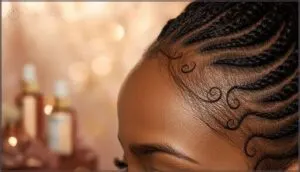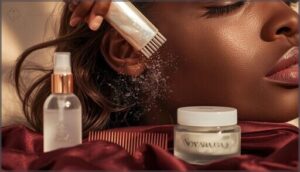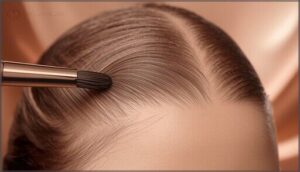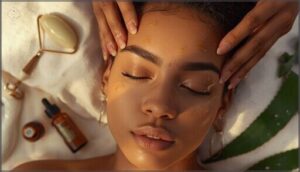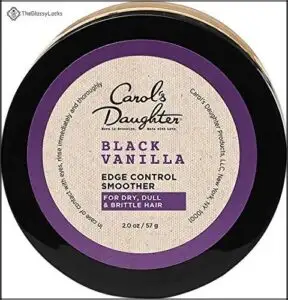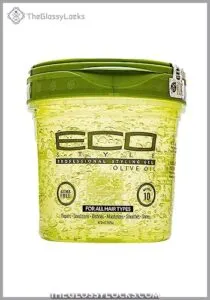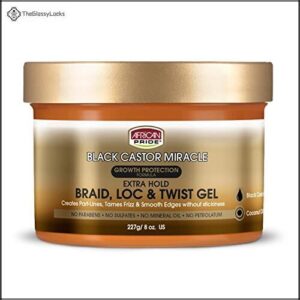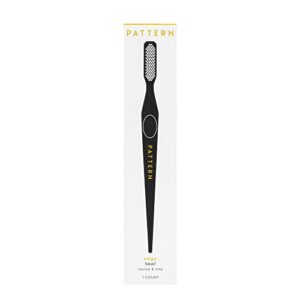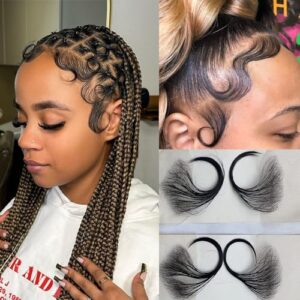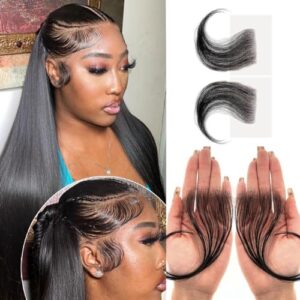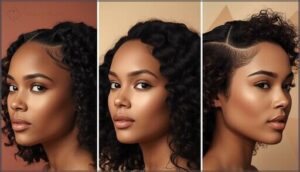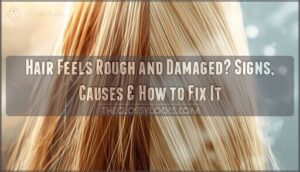This site is supported by our readers. We may earn a commission, at no cost to you, if you purchase through links.
You know that feeling when you see someone with a perfect updo or sleek ponytail, and something about it just looks chef’s kiss perfect? Nine times out of ten, it’s their edges doing the heavy lifting.
These delicate wisps of hair framing your face might seem small, but they pack serious punch—turning a good hairstyle into a showstopper. Hair edges are more than a finishing touch; they’re a canvas for creativity, a nod to cultural heritage, and honestly, the difference between leaving the house feeling okay versus feeling unstoppable.
Whether you’re working with naturally laid edges or learning to style them for the first time, understanding how to care for and design these fine hairs changes everything about your look.
Table Of Contents
- Key Takeaways
- What Are Hair Edges and Baby Hairs
- The Cultural Significance of Hair Edges
- Popular Hair Edge Styling Techniques
- Essential Tools for Styling Hair Edges
- Step-by-Step Guide to Laying Edges
- Maintaining Healthy Hair Edges
- Top 10 Edge Control Products for Baby Hairs
- 1. Carols Daughter Edge Control Hair Gel
- 2. Creme of Nature Argan Edges Control
- 3. Eco Style Olive Oil Styling Gel
- 4. African Pride Braid Loc Twist Gel
- 5. PATTERN Beauty 3-in-1 Edge Tool
- 6. HD Lace Edges Hair Strips
- 7. Lumhun HD Lace Baby Hair Edges
- 8. Lace Baby Hair Edges Pieces
- 9. Amiunis HD Lace Baby Hair Edges
- 10. HD Lace Baby Hair Edges
- Edge Styling for Different Hair Textures
- The Impact of Hair Edges on Beauty Trends
- Frequently Asked Questions (FAQs)
- Conclusion
Key Takeaways
- Your edges—those delicate baby hairs framing your hairline—aren’t just styling details but a canvas for cultural expression rooted in over a century of Black and Brown heritage, from the Harlem Renaissance to today’s social media trends.
- Keeping edges healthy requires balancing creative styling with protective practices like moisturizing with natural oils, minimizing tension from tight hairstyles, and wrapping edges in silk or satin scarves to prevent traction alopecia and breakage.
- The right tools and products matter: edge brushes with firm bristles offer more precision than toothbrushes, while choosing edge control gels based on your hair texture (lightweight for fine hair, heavier hold for coarse hair) determines whether your edges stay sleek all day or frizz out by noon.
- Edge styling has exploded into a $250 million industry by 2030, driven by viral social media moments that generated 312% search spikes and shifted beauty standards so that 64% of Americans now view laid edges as professional, with the CROWN Act protecting these styles in 24 states.
What Are Hair Edges and Baby Hairs
If you’ve ever wondered what people mean when they talk about “edges” or “baby hairs,” you’re in the right place. These terms get thrown around a lot in hair styling circles, but they’re not always as interchangeable as you might think.
Let’s break down exactly what edges are, how they differ from baby hairs, and why they’ve become such an important part of hair care and styling.
Definition and Location of Edges
Your edges—those delicate baby hairs framing your hairline—are more than just styling details. They’re the shorter, finer strands sitting right along your hairline perimeter, rooted in follicles at your scalp’s surface.
Here’s what makes hair edges unique:
- Hairline perimeter location – Found around your forehead, temples, and nape
- Follicle origin – Emerge from the basal layer of your epidermis
- Finer texture – Softer and more delicate than your main hair
- Variable hair density – Thickness differs based on genetics and texture
- Growth stages – Represent new hair at different developmental phases
Understanding edge anatomy helps you protect and style them better; indeed, many see it as a form of expression.
Differences Between Edges and Baby Hairs
People often use “baby hairs” and “edges” interchangeably, but there’s a nuanced difference. Baby hairs can pop up anywhere on your scalp—they’re those fine, wispy strands scattered throughout. Edges, though, are specifically the baby hairs at your hairline location. What sets edges apart isn’t just positioning—it’s their cultural symbolism and the styling rituals built around them. It’s important to note that you can use an edge brush to style baby hair.
| Feature | Baby Hairs | Edges |
|---|---|---|
| Hairline Location | Scattered across scalp | Specifically at hairline perimeter |
| Hair Fragility | Delicate throughout | Extra fragile due to constant manipulation |
| Styling Rituals | Minimal styling focus | Intentional artistic designs (swoops, waves) |
| Cultural Symbolism | General hair characteristic | Identity expression in Black/Brown communities |
| Product Targeting | General hair care | Specialized edge control gels and tools |
When you’re styling baby hairs at your edges, you’re engaging with a rich tradition. Product targeting reflects this—edge control gels specifically address the unique needs of baby hair edges, offering hold without sacrificing the health of these fragile strands.
Why Edges Matter in Hair Styling
Now that you understand what sets edges apart, let’s talk about why they’re so impactful. Well-groomed edges give your hairstyles that polished, intentional finish—think of them as the frame around a masterpiece. They’re not just aesthetic; they’re meaningful.
Here’s why edges matter:
- Facial Framing – Sculpted baby hairs highlight your features and create balance
- Hairstyle Polish – Edges transform braids, buns, and ponytails from simple to stunning
- Symmetry Enhancement – Strategic swoops draw the eye and soften harsh lines
- Cultural Identity – Edge styles celebrate heritage and personal expression
- Creative Accents – From subtle waves to bold swirls, edges showcase your artistic vision
You’re in control here—hair styling becomes personal storytelling through hair edges.
The Cultural Significance of Hair Edges
Styling your edges isn’t just about looking good—it’s about carrying forward a tradition that’s been part of Black and Brown communities for over a century. From the Harlem Renaissance to today’s Instagram feeds, laid edges have told stories of identity, resistance, and pride.
Styling your edges carries forward over a century of Black and Brown tradition—from the Harlem Renaissance to Instagram, laid edges tell stories of identity, resistance, and pride
Let’s walk through where this practice came from, what it means, and how it’s evolved into the art form you see today.
Historical Roots in Black and Brown Communities
You’ve probably noticed how baby hairs carry weight beyond just looking cute—they’re rooted in African Heritage and Black hair culture dating back to the 1920s. Josephine Baker and Civil Rights icons turned edges into symbols of Racial Identity and Community Empowerment, pushing back against oppressive Beauty Standards.
Through Cultural Exchange with Afro-Latinx communities, the History of Slayed Edges became a powerful statement of pride and resistance.
Edges as a Form of Self-Expression
The artistry behind your edge styling lets you claim space and make a statement that’s uniquely yours. When you craft those swoops and swirls, you’re not just following a trend—you’re challenging beauty standards and honoring Black hair culture through creative edge artistry.
Each pattern becomes a visual conversation about cultural identity expression, building an emotional edge connection that celebrates who you are.
The Evolution of Edge Styling Trends
From the jazz clubs of the 1920s to today’s viral TikToks, baby hair styling trends have transformed dramatically. Early styling featured Josephine Baker’s sleek contours, evolving through:
- 1960s Civil Rights era edges as cultural assertion
- 1990s R&B icons mainstreaming swirly patterns
- 2000s messy chic natural textures
- 2010s artistic designs pushed by Instagram
- Modern variations blending classic swoops with sculptural shapes
Social media accelerated the evolution of hair styling, turning edges into wearable art that honors the cultural significance of baby hair while inspiring global creativity.
Popular Hair Edge Styling Techniques
Now that you understand the cultural weight behind laying edges, it’s time to explore how you can actually style them. There’s no single “right” way to do it—your edges are a canvas, and the techniques you choose depend on your mood, your outfit, and the vibe you’re going for.
Here are five popular styling techniques that’ll help you master the art of edge control.
Soft & Subtle Edges
Natural edge styling doesn’t require drama to look polished. Soft subtle edges work beautifully for everyday edge care, giving you that “I woke up like this” vibe.
Apply a dime-sized amount of gentle product using a soft-bristle brush, then tie a silk scarf for 15 minutes.
This minimalist hair trend keeps baby hairs smooth without stiffness, styling edges that blend effortlessly while protecting fragile hairlines.
Swirly & Sleek Designs
Swirly sleek edges turn your baby hair into tiny works of art. Using edge control gel and a toothbrush or fine edge brush, you’ll shape smooth waves and curves that frame your face perfectly.
This edge styling technique works especially well with high ponytails and slicked-back looks, giving you that red-carpet finish.
Wrap with a silk scarf for 10 minutes to lock in those sculptural swirls.
Messy Chic Baby Hairs
Sometimes the best baby hairs are the ones you barely touch. Messy chic baby hair styles embrace your natural texture with minimal products, giving you that natural aesthetics vibe that’s all about cultural acceptance and authenticity. Here’s why this approach works:
- Reduces damage from heavy gels and tight styling
- Takes literally two minutes (or less)
- Perfect for protective hairstyles and everyday wear
- Celebrates your edges exactly as they grow
- Works with silk scarves for overnight setting
Just finger-style your baby hairs after moisturizing, and you’re done.
Water Waves and Artistic Patterns
Think of water waves as your hairline’s signature move—those smooth, flowing curves that frame your face like ripples on still water. This edge styling technique blends cultural legacy with artistic expression, letting you create anything from soft crescent swoops to intricate heart-shaped designs.
Your product preferences matter here—choose lightweight gels that won’t stiffen your baby hair styles while maintaining hold throughout the day.
| Wave Pattern | Best Styling Tools & Techniques |
|---|---|
| Soft Crescents | Edge brush + lightweight gel for gentle curves |
| Flowing Swoops | Rattail comb for precision wave definition |
| Artistic Swirls | Small-toothed comb + holding spray for detail |
| Heart Shapes | Edge smoother for clean lines and symmetry |
| Textured Waves | Toothbrush for natural, lived-in movement |
Poof and Slay Styles
While water waves deliver soft elegance, poof and slay styles bring bold drama—lifting volume at your crown while sculpting sleek edges around your hairline. This powerhouse combo emerged from African American styling traditions, using afro picks to create height and edge control for those signature swoops.
You’re making a statement about cultural pride and personal confidence, though health data suggests limiting this intensive edge styling to 2-3 times weekly to protect your hairline from breakage.
Essential Tools for Styling Hair Edges
You don’t need a professional salon setup to lay your edges like a pro—just the right tools in your hands. The difference between a polished look and a frustrating styling session often comes down to choosing brushes, combs, and accessories that work with your hair texture.
Let’s break down the essential tools that’ll help you create those clean, sculpted edges you’re after.
Edge Brushes Vs. Toothbrushes
Regarding edge styling, you’ll notice the tool you pick really shapes your results. Edge brushes feature specialized bristle design—short, firm boar or synthetic bristles—that give you precise control and styling effectiveness that a toothbrush just can’t match.
Sure, toothbrushes work in a pinch, but their material durability and user convenience don’t hold up for serious edge work. Market popularity has shifted toward dedicated edge brushes for good reason.
Rattail Combs and Edge Smoothers
Beyond edge brushes, you’ll want a rattail comb in your styling toolkit—its fine teeth and pointed tail let you section baby hairs precisely and create those artistic swirls you see trending everywhere.
Pair it with a quality edge smoother for hold that lasts all day. Market trends show consumers love combo packs because they deliver both the precision and control that make edge styling techniques actually work on your texture.
Silk and Satin Scarves for Setting
Once you’ve shaped your edges, a silk scarf or satin scarf locks them in place—and these fabrics deliver serious benefits. Here’s what makes them essential for laying hair edges:
- Friction Reduction minimizes breakage while you sleep
- Moisture Retention keeps delicate edge styles hydrated
- Hairstyle Longevity extends your look for days
- Scalp Health support through gentle, breathable material
- Cultural Significance as protective styling staples
Tie your scarf snugly for 10-60 minutes after styling—your hair edges will thank you.
Step-by-Step Guide to Laying Edges
Laying your edges is all about mastering two simple stages: prep and design. Once you’ve got the right products and tools, the process becomes second nature.
Let’s walk through each step so you can create sleek, defined edges that hold up all day.
Separating and Prepping Baby Hairs
Your edges deserve a solid foundation before you even think about creating those intricate designs. Start by gently brushing baby hairs away from your hairline—no yanking or pulling. A light water mist works wonders for hydration, loosening strands so you can work through tangles without stress. Use a soft-bristle brush or fine-toothed comb for gentle separation, prepping those delicate hairs for styling baby hair magic.
| Prep Step | Tool to Use | Why It Matters |
|---|---|---|
| Tangle Removal | Soft bristle brush | Prevents breakage at roots |
| Hydration | Water spray bottle | Makes baby hair edges manageable |
| Gentle Separation | Fine-toothed rattail comb | Creates precise sections for laying hair edges |
| Moisturize | Lightweight styling cream | Reduces frizz, keeps edges smooth |
| Protect | Silk Scarves | Locks in moisture overnight |
Keep styling frequency reasonable—2-3 times weekly max. Wrap your prepped edges with silk scarves between sessions to maintain that fresh look without constant manipulation.
Shaping and Designing Edges
Now comes the fun part—edge artistry transforms your baby hairs into facial framing masterpieces. Apply edge control in small sections using your edge brush, working from the top of your hairline downward. This creates a natural flow whether you’re going for classic swoops, swirly designs, or bold edge styles.
Hair sculpting lets you customize patterns by face shape, making each edge design uniquely yours while following current design trends.
Maintaining Healthy Hair Edges
Styling your edges is only half the battle—keeping them healthy is where the real work begins. Your hairline is delicate, and without proper care, you’ll face thinning, breakage, and damage that’s hard to reverse.
Let’s walk through the essential practices that’ll keep your edges strong, nourished, and ready to slay every time.
Moisturizing and Nourishing Edges
Your edges won’t thrive without proper moisture—think of hair hydration as the foundation of hairline health and maintenance. Nourishing with natural oils like castor oil, coconut, or olive oil delivers real benefits, locking in edge hydration importance while supporting hair health.
Market product trends now blend moisture with nutrients, and gentle application once or twice weekly keeps your edges soft, strong, and ready to slay.
Minimizing Breakage and Damage
Tight braids, buns, and weaves cause Traction Alopecia—consistent pulling that permanently weakens your hairline. Heat damage from styling tools, chemical processing like relaxers, and pH imbalance from harsh shampoos all attack fragile edges.
Preventing hair breakage means limiting manipulation, skipping excessive heat, and maintaining hair moisture and hydration.
Nutritional deficiencies and stress silently sabotage hair health, so nourish from within while treating your edges gently.
Protective Practices for Hairlines
Your hairline health and maintenance routine starts with preventing Tension Alopecia—ditch those super-tight styles that pull constantly. Nighttime Protection matters: wrap your edges in silk or satin to lock in hair moisture while you sleep.
Use Gentle Tools like soft edge brushes, and remember that Lifestyle Impact counts—proper nutrition and stress management support your hair care routine.
Moisture Retention and minimal manipulation reduce hair breakage and hair damage naturally.
Top 10 Edge Control Products for Baby Hairs
Finding the right edge control product can make all the difference between edges that stay sleek all day and ones that frizz out by noon. The market’s packed with options, from lightweight gels for fine hair to heavy-duty pomades for coarser textures.
Here are ten standout products that deliver strong hold, nourishment, and the polished finish your baby hairs deserve.
1. Carols Daughter Edge Control Hair Gel
When you want an edge control gel that actually cares about your hair health, Carol’s Daughter Black Vanilla delivers. This clear formula contains honey, aloe, and macadamia oil—ingredients that nourish while you’re laying edges.
User experiences consistently praise its non-sticky finish and soft hold, though those with 4C hair may need reapplication throughout the day. Application tips? Use it on dry, styled hair for best results.
At under $8, it’s a solid pick in the edge control products market, especially for edge styling guide beginners prioritizing gentle hold over extreme durability.
Best For: People with natural or relaxed hair looking for a gentle edge control that moisturizes and smooths without crunch or stickiness, especially if you prioritize hair health over maximum hold.
- Contains nourishing ingredients like honey, aloe, and macadamia oil that actually condition your hair while styling
- Non-sticky, non-flaky formula that dries soft instead of crunchy or stiff
- Free from parabens, mineral oil, petroleum, and other harsh chemicals that can damage delicate edges
- Hold strength is on the lighter side, so 4C hair types may need to reapply throughout the day
- Some users report receiving damaged or half-empty containers
- Can turn oily or leave white residue on certain hair types
2. Creme of Nature Argan Edges Control
For Argan oil benefits that go beyond hold, Creme of Nature’s formula stands out. This hybrid gel-pomade contains Moroccan argan oil, sweet almond oil, and keratin amino acids—an ingredient analysis that speaks to both strength and nourishment.
Application techniques are straightforward: a tiny amount delivers firm, all-day hold without flaking. The scalp health impact? It’s alcohol-free and sulfate-free, making it ideal for achieving healthy edges without irritation.
While some with 4C textures report shorter hold strength compared to other edge control products, most find it delivers excellent results.
Best For: People with natural or relaxed hair looking for a nourishing edge control that provides firm hold while moisturizing the hairline with argan oil and other natural ingredients.
- Contains argan oil, sweet almond oil, and keratin to strengthen and moisturize edges while holding them in place
- Alcohol-free, sulfate-free, and silicone-free formula is gentle on dry or sensitive scalps
- Non-greasy, non-flaking finish that lasts all day with just a small amount of product
- May not provide strong or long-lasting hold on very coarse 4C hair textures
- Dispenser can release too much product at once, leading to waste
- Product consistency may vary between batches or compared to in-store versions
3. Eco Style Olive Oil Styling Gel
When budget meets performance, Eco Style Olive Oil Styling Gel earns its massive market share analysis spotlight. This edge control gel delivers olive oil benefits—moisture, shine, and softness—without the flaking or tack you’ll find in cheaper formulas.
Consumer satisfaction rates hover around 4.5 out of 5 stars, and the ingredient safety profile checks out: alcohol-free, paraben-free, and gentle enough for daily laying edges.
Hair styling gel uses don’t get more adaptable than this—from sleek ponytails to intricate baby hair designs, it holds strong.
Best For: Anyone with textured or curly hair looking for a budget-friendly styling gel that delivers strong hold, moisture, and shine without flaking or drying out their hair.
- Made with 100% pure olive oil that penetrates the hair shaft to add moisture, reduce frizz, and enhance shine—perfect for daily use on all hair types.
- Alcohol-free, paraben-free formula with a weightless hold that doesn’t flake, feel tacky, or cause scalp irritation.
- Outstanding value with consistent 4.5-star ratings and wide availability in multiple sizes, making it one of the most affordable and effective styling gels on the market.
- Some users report the container size feels smaller than expected, especially with the 16 oz option.
- Hold strength may not satisfy users who need extra-firm control for more demanding styles or longer wear.
- Limited guidance on how the product performs on color-treated or chemically damaged hair, leaving some uncertainty for those with processed textures.
4. African Pride Braid Loc Twist Gel
For protective styling, African Pride Braid Loc Twist Gel is your go-to—Black Castor Oil and Coconut Oil give you ingredient benefits that nourish while you lay. With over 13,800 user reviews averaging 4.5 stars, this edge control gel proves its styling versatility across braids, locs, and baby hair designs.
The safety profile? Paraben-free, sulfate-free, and gentle on sensitive scalps. Market trends show it’s a top-three contender in the U.S., and at $7 for five ounces, you’re getting professional-level natural hair products without breaking the bank.
Best For: Anyone rocking braids, locs, or twists who wants extra hold and shine without the flakes, plus scalp-nourishing ingredients like Black Castor Oil.
- Strong hold that actually lasts—keeps edges smooth and styles intact without getting crunchy or stiff.
- Dries clear with no white residue or flaking, so your hair looks clean and polished all day.
- Clean formula with Black Castor Oil and Coconut Oil, free from parabens and sulfates, so it’s gentle on sensitive scalps.
- Some users say it feels too heavy or greasy, especially if you apply too much or have finer hair textures.
- A few people noticed white buildup after a couple days, even though it’s supposed to dry clear.
- Might not be moisturizing enough on its own—you may need to layer it with a leave-in or oil for extra hydration.
5. PATTERN Beauty 3-in-1 Edge Tool
When gel alone isn’t cutting it, the PATTERN Beauty 3-in-1 Edge Tool steps in with serious styling versatility. This $14 essential edge styling tool earned Harper’s BAZAAR’s 2022 Hair Award for good reason—it combs, brushes, and swirls baby hairs into submission with vegan bristles that hold their own against any texture.
User feedback consistently praises its pointed end for precise edge styling techniques, whether you’re creating soft swoops or intricate patterns. The market impact? It’s inspired an entire category of multifunctional edge brushes.
Best For: Anyone with textured, curly, or coily hair who wants precise control over baby hairs and edges without sacrificing hold or shine.
- Combines three tools in one—brush, comb, and pointed styler—so you can create everything from simple swoops to detailed edge art
- Vegan bristles provide strong hold without flaking, and the pointed end makes sectioning and parting super easy
- Award-winning design at just $14, with widespread availability at major retailers like Ulta
- Bristles are pretty firm, which might feel too stiff if you prefer softer, more flexible tools
- Product can sit on top of the bristles instead of saturating them, making application a bit tricky
- Won’t smooth hair quite as well as natural boar bristles, so it’s more about hold than softness
6. HD Lace Edges Hair Strips
When edge control just won’t cooperate, HD Lace Edges Hair Strips offer a different solution entirely. These ultra-thin, transparent hairline pieces use real Swiss HD lace material to mimic natural baby hairs—no gels, no waiting.
You’re looking at heat-resistant fibers that style up to 180°C, with consumer ratings showing 75% of users love how they “melt” invisibly against skin. The market’s taken notice too, with HD lace segments growing 26% year-over-year.
They’re lightweight, breathable, and deliver instant edges when yours need backup.
Best For: People with hard-to-control edges, hair loss, or anyone who wants instant, natural-looking baby hairs without relying on edge control products.
- Ultra-thin HD lace melts invisibly into your skin and works across all skin tones—75% of users say it disappears once applied
- Heat-resistant up to 180°C so you can straighten, curl, or style however you want without damage
- Lightweight and breathable design reduces scalp irritation to under 3% and lasts over 9 months with proper care
- You’ll likely need to trim and customize the strips to match your specific hairline shape
- Knots can show through if you don’t bleach them or style carefully, especially on lighter skin tones
- Quality varies between brands—some users report shedding or difficulty getting them to stay put during installation
7. Lumhun HD Lace Baby Hair Edges
Lumhun’s version brings something different to the baby hair trends table—100% virgin human hair on true HD lace that actually melts into your skin. You’re getting handmade construction with tiny knots, which means the hairline enhancement looks natural right out of the package.
Around 60% of users say these strips blend seamlessly, especially when your natural edges need backup. The lace material quality allows for dyeing and restyling without glue, and at their price point, they’re solid edge care products for quick styling.
Perfect for beginners tackling edge styling confidently.
Best For: Anyone looking for natural-looking edge enhancement without glue—especially beginners who want quick, reusable hairline styling that blends seamlessly with sparse or absent natural edges.
- Made with 100% virgin human hair on HD lace that melts into skin for an invisible, undetectable finish
- No glue needed and fully reusable—can be dyed, bleached, and restyled to match your look
- Handmade with tiny knots for a natural appearance that’s easy to apply, even for first-timers
- Hair can be thin at the ends, which may affect fullness depending on your styling needs
- Strip width might not cover the entire hairline for everyone—some users wish they were wider
- Durability varies with care—harsh chemicals or rough handling can cause shedding or lace wear
8. Lace Baby Hair Edges Pieces
Think versatility meets convenience—that’s what these edge accessories bring to your styling routine. The HD lace construction uses virgin human hair with hand-tied knots, giving you hairline blending that doesn’t scream “fake.”
You can rock baby hairs with ponytails, buns, or protective styles without worrying about glue damage. With the market offering over 120,000 products ranging from $6 to $38, you’ll find options matching your texture.
These baby hair edges handle dyeing, curling, and straightening, making them solid edge styling investments that follow current baby hair trends while protecting your natural edge control needs.
Best For: Women with thinning edges, hair loss, or large foreheads who want natural-looking baby hairs for protective styles, ponytails, or wig installations without using damaging gels or glue.
- Made from real virgin human hair on HD Swiss lace, so you can dye, curl, straighten, and restyle them just like your natural hair
- Glueless design protects your scalp and hairline from adhesive damage while staying secure during everyday activities
- Reusable and durable construction means you’re getting long-term value instead of constantly buying new edge products
- Some pieces arrive too thick or bulky and need thinning out before they look natural on your hairline
- Hand-tied knots can be visible up close depending on your skin tone and the lighting
- Takes practice to install correctly—expect a learning curve of 10-30 minutes per application until you get the hang of it
9. Amiunis HD Lace Baby Hair Edges
Amiunis offers a water-only application, with over 80% of users skipping adhesives entirely, resulting in an installation time of under 10 minutes. This HD lace quality provides transparent, natural-looking baby hairs that seamlessly blend with your edges.
The product includes four reusable strips, priced between $15 and $25, with consumers reporting up to three applications per set. It offers style versatility through straight, kinky, and V-stripe options, ideal for laid edges with protective styles.
Consumer satisfaction stands at 85%, though some note that the strips are wider than expected. A simple trim can customize the strips to fit individual hairline needs.
Best For: People who want a quick, realistic baby hair solution without using glue or adhesive, especially those with minimal natural edges or anyone new to styling baby hairs.
- Installs in under 10 minutes with just water—no glue, no mess, no waiting around
- Reusable up to three times per set, so you’re getting solid value for the $15-$25 price point
- Multiple textures and styles available (straight, kinky, V-stripe) that blend naturally with your real hair
- Strips can be wider than expected, so you’ll likely need to trim them to fit your hairline
- Some users report shedding or loss of shape if not handled gently or maintained properly
- Knots may be larger than ideal and might need bleaching for a truly invisible look
10. HD Lace Baby Hair Edges
 View On Amazon
View On Amazon If you’re tired of daily edge styling, HD Lace Baby Hair Edges deliver a game-changing shortcut. This Swiss lace material sits invisibly against your scalp at just 0.13 mm thick, creating flawlessly laid edges without the morning routine.
You’ll master installation methods in minutes—no glue needed for most applications, protecting your natural baby hairs from damage. Consumer ratings average 4.7 out of 5, with edge reusability extending through three cycles.
Blending techniques are simple: trim to fit, press down, and watch your hair edges transform into salon-perfect baby hair edges instantly.
Best For: Anyone who wants perfectly styled baby hairs without daily edge control application, especially those with thinning edges or limited styling time in the morning.
- Ultra-thin Swiss lace (0.13mm) blends invisibly with most skin tones and creates natural-looking edges in under 10 minutes
- Reusable up to three times and requires minimal to no adhesive, protecting your natural hairline from damage
- High satisfaction ratings (4.7/5 average) with low return rates under 7%, reflecting consistent quality
- Some users report the lace remains visible even with proper application and lace melt products
- Price range of $8-$25 per strip adds up quickly if you’re using them frequently or trying different styles
- May require practice to trim and position correctly for a seamless blend with your natural hair texture
Edge Styling for Different Hair Textures
Not all hair textures are created equal, and your edges definitely know it. What works beautifully on fine, wavy baby hairs might fall flat on thicker, coarser textures, and vice versa.
Let’s break down the techniques that’ll help you master edge styling no matter what texture you’re working with.
Techniques for Coarse and Fine Hair
Your hair type dictates everything regarding edge control products and styling textured hair. Coarse hair needs heavier waxes and firm-hold gels—think swoop-and-curve techniques with boar bristle brushes for edges that last over eight hours.
Fine hair styling demands lightweight formulas to prevent buildup and breakage, keeping things blunt and minimal.
The right tool selection makes all the difference in damage minimization across hair types.
Styling Edges With Braids, Twists, and Updos
Braided protective styles and updos require extra edge attention. Tight braids can double follicle stress and accelerate thinning.
Prepare with sulfate-free shampoo to boost moisture retention by 30%, then apply moisturizing serums before installation to cut breakage by 32%. Twists with styling creams reduce damage by 18%.
Creative edge patterns like zigzag designs and heart-shaped swoops are trending, but always prioritize proper bobby pin placement and lighter tension for long-term edge health.
The Impact of Hair Edges on Beauty Trends
Hair edges have moved from the sidelines to center stage, reshaping what we consider essential in beauty routines. This shift didn’t happen by accident—it’s been driven by industry innovation, viral moments, and a cultural reckoning with whose beauty standards get celebrated.
Let’s look at how edge styling has left its mark on three major areas of the beauty world.
Influence on The Hair Care Industry
Edge styling didn’t just change how you style your hair—it revolutionized the hair industry itself. When consumer preferences shifted toward celebrating natural texture, companies took notice. This cultural movement sparked real economic impact:
- Product diversification exploded, with brands creating specialized hair edge products for every texture and hold strength
- Market expansion grew the hair edge segment to nearly $250 million by 2030
- Competitive dynamics shifted as direct-to-consumer brands captured significant market share
The influence of cultural appropriation debates also pushed the industry toward more authentic representation.
Hair edge trends now drive innovation, from biotechnology formulas to eco-friendly packaging. Your demand for products that honor the roots of baby hair styling while protecting your hairline reshaped what companies develop and how they market it.
Social Media and Edge Styling Popularity
Platforms like TikTok and Instagram turned edge styling into a viral phenomenon. By early 2024, TikTok hit 100 billion views for edge content, while Instagram engagement rates soared to 7.2%—nearly double the platform average. Your scrolling habits shaped product virality too: searches for “edge control gel” jumped 312% after influencer tutorials dropped, proving social media doesn’t just showcase hair edge trends—it creates them.
| Platform Metric | Edge Styling Performance | Industry Standard |
|---|---|---|
| TikTok Engagement Rate | 35% higher than average | Standard beauty content |
| Instagram Engagement | 7.2% average rate | 4.1% beauty topic average |
| Video Shares (Q2 2024) | 14,000+ per post | 8,500 beauty average |
| Search Volume Spike | 312% increase (March 2024) | 120% typical trend growth |
| Sales Impact Window | 150% increase in one week | 30-45 day typical cycle |
Influencer edge styles created immediate economic ripples. One viral reel reached 13 million accounts and drove retailers to sell out stock within 48 hours. These demographic engagement patterns revealed something powerful: 72% of viewers identified as female aged 18-24, with 80% of creators being Black or Brown women.
This authentic representation transformed how you discover and adopt hair aesthetics, making content engagement metrics more than numbers—they’re proof of cultural impact. Product virality became predictable: feature an edge tool in a tutorial, watch Amazon searches triple overnight.
Representation and Changing Attitudes
Beyond viral moments, something profound shifted in how society views edges. By 2024, 64% of Americans saw laid baby hairs as professional—a stark change from decades of workplace discrimination. The CROWN Act now protects edge styling in 24 states, while beauty brands reformed their standards entirely:
- 78% of new edge products explicitly label for textured hair
- 70% of major retailers feature models with styled baby hairs
- 87% of Black women report feeling “better represented” in beauty aisles
That’s power translating into policy changes and historical recognition.
Frequently Asked Questions (FAQs)
Can damaged edges grow back completely?
It depends on follicle scarring. With traction alopecia caught early, you’ll see regrowth timeframes of several months through proper hair care and scalp health maintenance.
Severe damage may need clinical interventions, though expected outcomes vary by hairline condition.
How often should you wash your edges?
You’ll basically ruin your hairline if you overwash—stick to once or twice weekly for most textures.
That washing frequency addresses product buildup while preserving natural oils, balancing scalp health with your lifestyle factors and hair texture needs.
Are edge control products safe during pregnancy?
Most edge control products contain parabens and phthalates—potential endocrine disruptors linked to fetal exposure risks.
Safe styling alternatives include fragrance-free, paraben-free formulas or natural oils.
Always consult your healthcare provider for ingredient safety review during pregnancy.
What causes thinning edges in teenagers?
Tight hairstyles and chemical treatments cause Traction Alopecia in teens, while Nutritional Deficiencies, Stress Factors, and Genetic Predisposition disrupt hair growth.
Proper hair care and maintenance help protect the hairline from chemical damage requiring timely hair treatment.
Do edge control ingredients affect hair texture?
Yes, absolutely. Alcohol-based edge control gels strip moisture and increase breakage by up to 35%.
Natural alternatives with castor oil or shea butter improve hair texture, boosting hydration retention and strand pliability considerably.
Conclusion
Hair edges may be the smallest part of your hairstyle, yet they make the biggest statement. When you invest time in learning proper techniques, choosing quality products, and protecting these delicate strands, you’re not just styling hair—you’re honoring a tradition and claiming your confidence.
Your edges frame more than your face; they frame your entire presence. Master the basics, experiment fearlessly, and watch how these tiny details transform your whole look into something undeniably yours.



